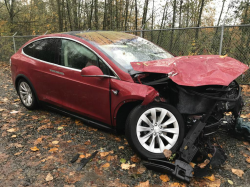
— A Tesla unintended acceleration class action lawsuit alleges hardware and software defects cause uncommanded acceleration incidents in Tesla Model 3, Model S and Model X vehicles.
The class action lawsuit accuses Tesla of intentionally manufacturing and selling 2013-2020 Model S, 2016-2020 Model X and 2018-2020 Model 3 vehicles with known defects.
"Given Tesla’s always perilous cash-flow situation and the ferociousness of its competition, it is easy to understand why Tesla’s strategy is to release vehicles first and fix their problems later." - Lawsuit
The class action was filed just days after the National Highway Traffic Safety Administration (NHTSA) announced it had received a petition to investigate unintended acceleration incidents. The petitioner, a Tesla stock short-seller, alleges sudden acceleration complaints have been filed about 123 Tesla vehicles, allegedly causing 110 crashes and 52 injuries.
NHTSA hasn't decided if a federal investigation is necessary, but Tesla responded to the petition by alleging complaints about sudden unintended acceleration are routinely reviewed with NHTSA.
The automaker says the reviews have occurred with the government for several years and in every case the data proved the vehicles operated normally.
"In other words, the car accelerates if, and only if, the driver told it to do so, and it slows or stops when the driver applies the brake." - Tesla
Tesla also says each of the three models is equipped with two independent position sensors that cause the system to kill the motor if errors occur. The automaker also says applying the accelerator pedal and the brake pedal at the same time overrides input from the accelerator.
Based on complaint records, the vast majority of drivers say their vehicles experienced sudden unintended acceleration while traveling at slow speeds, often while pulling into parking lots or parking spaces. This is the very time during a trip when a driver would be using both the brake pedal and accelerator pedal.
According to Tesla, the timing of the incidents isn't a coincidence because data from the vehicles show drivers are mistakenly pressing the accelerator pedals instead of the brake pedals. And with the incredibly quick response times of the electric vehicles (zero to 60 mph in 2.9 seconds), a split-second is all it takes to send a vehicle reeling through a storefront.
The lawsuit accuses Tesla of intentionally designing the vehicles to record data which shows a driver pressed the accelerator pedal as part of a "computerized cover-up" to conceal defects.
"And, to add insult to very real injury, it appears that Tesla has designed the automobile’s sensors to report after such incidents that the driver deployed the accelerator pedal. In other words, the automobile inexplicably speeds up, then blames the driver." - Tesla lawsuit
Although the plaintiffs claim they know the vehicles have defects that cause sudden uncommanded acceleration (SUA), none of the plaintiffs say they know what the defects are.
"Unfortunately, Plaintiff does not yet know the exact nature of the SUA Defect, because Tesla vehicles are a black box by design. Tesla’s secrecy has made it impossible to determine the specific nature of the SUA Defect, or why its flawed software is causing its vehicles to engage in uncommanded acceleration." - Tesla lawsuit
After admitting they don't know what the defects are, the plaintiffs go on to tell the judge to have faith the cars are defective.
"For now, it is enough to understand that these defects are manifest in Tesla vehicles, and thus endangering Tesla owners, occupants, and the general public."
According to the unintended acceleration class action, Model 3, Model S and Model X vehicles are "defective and unsafe" even if the evidence shows a driver is responsible for the acceleration incident by pressing the wrong pedal.
"Irrespective of whether the Tesla-related SUA events are caused by mechanical issues with the accelerator pedal, an unknown failure in the electronic motor control system, a failure in other aspects of the electrical, mechanical, or computer systems, or some instances of pedal misapplication, the Model S, Model X, and Model 3 are defective and unsafe."
The lawsuit seeks an order that requires Tesla to repair, recall and/or replace the Model 3, Model S and Model X vehicles.
The Tesla unintended acceleration class action lawsuit was filed in the U.S. District Court for the Central District of California: Lee, et al., v. Tesla, Inc. et al.
The plaintiffs are represented by McCune Wright Arevalo, and Bailey Glasser.
In a previous proposed Tesla unintended acceleration class action lawsuit, Tesla said no automaker manufactures cars that are failsafe, something Tesla drivers apparently don't understand.




